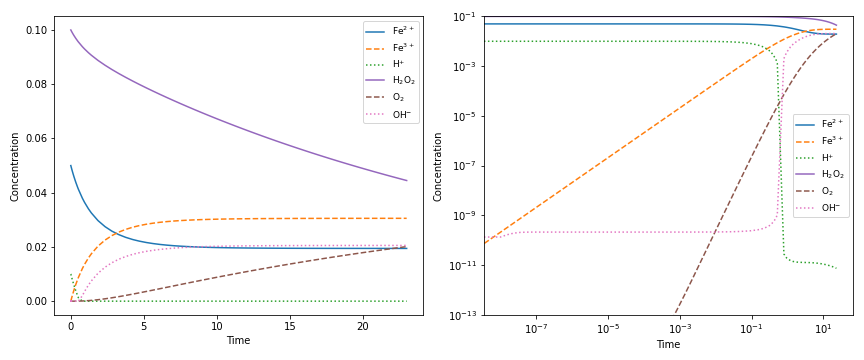ChemPy is a Python package useful for solving problems in chemistry.
Project description







About ChemPy
ChemPy is a Python package useful for chemistry (mainly physical/inorganic/analytical chemistry). Currently it includes:
Solver for equilibria (including multiphase systems)
Numerical integration routines for chemical kinetics (ODE solver front-end)
Integrated rate expressions (and convenience fitting routines)
Relations in physical chemistry:
Debye-Hückel expressions
Arrhenius equation
Einstein-Smoluchowski equation
Properties
water density as function of temperature
water permittivity as function of temperature and pressure
water diffusivity as function of temperature
sulfuric acid density as function of temperature & weight fraction H₂SO₄
Documentation
Auto-generated API documentation for the latest stable release is found here: https://bjodah.github.io/chempy/latest (and the development version for the current master branch is found here: http://hera.physchem.kth.se/~chempy/branches/master/html).
Installation
Simplest way to install ChemPy and its (optional) dependencies is to use the conda package manager:
$ conda install -c bjodah chempy pytest $ python -m pytest --pyargs chempy # runs the test-suite
alternatively you may also use pip:
$ python -m pip install --user --upgrade chempy pytest $ python -m pytest --pyargs chempy
you can skip the --user flag if you have got root permissions. See setup.py for optional requirements.
Examples
See demonstration scripts in examples/, and some rendered jupyter notebooks here: http://hera.physchem.kth.se/~chempy/branches/master/examples. You may also browse the documentation for more examples. Below you will find a few code snippets:
Parsing formulae
>>> from chempy import Substance
>>> ferricyanide = Substance.from_formula('Fe(CN)6-3')
>>> ferricyanide.composition == {0: -3, 26: 1, 6: 6, 7: 6} # 0 for charge
True
>>> print(ferricyanide.unicode_name)
Fe(CN)₆³⁻
>>> print(ferricyanide.latex_name + ", " + ferricyanide.html_name)
Fe(CN)_{6}^{3-}, Fe(CN)<sub>6</sub><sup>3-</sup>
>>> print('%.3f' % ferricyanide.mass)
211.955as you see, in composition, the atomic numbers (and 0 for charge) is used as keys and the count of each kind became respective value.
Balancing stoichiometry of a chemical reaction
>>> from chempy import balance_stoichiometry # Main reaction in NASA's booster rockets:
>>> reac, prod = balance_stoichiometry({'NH4ClO4', 'Al'}, {'Al2O3', 'HCl', 'H2O', 'N2'})
>>> from pprint import pprint
>>> pprint(reac)
{'Al': 10, 'NH4ClO4': 6}
>>> pprint(prod)
{'Al2O3': 5, 'H2O': 9, 'HCl': 6, 'N2': 3}
>>> from chempy import mass_fractions
>>> for fractions in map(mass_fractions, [reac, prod]):
... pprint({k: '{0:.3g} wt%'.format(v*100) for k, v in fractions.items()})
...
{'Al': '27.7 wt%', 'NH4ClO4': '72.3 wt%'}
{'Al2O3': '52.3 wt%', 'H2O': '16.6 wt%', 'HCl': '22.4 wt%', 'N2': '8.62 wt%'}Balancing reactions
>>> from chempy import Equilibrium
>>> from sympy import symbols
>>> K1, K2, Kw = symbols('K1 K2 Kw')
>>> e1 = Equilibrium({'MnO4-': 1, 'H+': 8, 'e-': 5}, {'Mn+2': 1, 'H2O': 4}, K1)
>>> e2 = Equilibrium({'O2': 1, 'H2O': 2, 'e-': 4}, {'OH-': 4}, K2)
>>> coeff = Equilibrium.eliminate([e1, e2], 'e-')
>>> coeff
[4, -5]
>>> redox = e1*coeff[0] + e2*coeff[1]
>>> print(redox)
20 OH- + 32 H+ + 4 MnO4- = 26 H2O + 4 Mn+2 + 5 O2; K1**4/K2**5
>>> autoprot = Equilibrium({'H2O': 1}, {'H+': 1, 'OH-': 1}, Kw)
>>> n = redox.cancel(autoprot)
>>> n
20
>>> redox2 = redox + n*autoprot
>>> print(redox2)
12 H+ + 4 MnO4- = 4 Mn+2 + 5 O2 + 6 H2O; K1**4*Kw**20/K2**5Chemical equilibria
>>> from chempy import Equilibrium
>>> from chempy.chemistry import Species
>>> water_autop = Equilibrium({'H2O'}, {'H+', 'OH-'}, 10**-14) # unit "molar" assumed
>>> ammonia_prot = Equilibrium({'NH4+'}, {'NH3', 'H+'}, 10**-9.24) # same here
>>> from chempy.equilibria import EqSystem
>>> substances = map(Species.from_formula, 'H2O OH- H+ NH3 NH4+'.split())
>>> eqsys = EqSystem([water_autop, ammonia_prot], substances)
>>> print('\n'.join(map(str, eqsys.rxns))) # "rxns" short for "reactions"
H2O = H+ + OH-; 1e-14
NH4+ = H+ + NH3; 5.75e-10
>>> from collections import defaultdict
>>> init_conc = defaultdict(float, {'H2O': 1, 'NH3': 0.1})
>>> x, sol, sane = eqsys.root(init_conc)
>>> assert sol['success'] and sane
>>> print(sorted(sol.keys())) # see package "pyneqsys" for more info
['fun', 'intermediate_info', 'internal_x_vecs', 'nfev', 'njev', 'success', 'x', 'x_vecs']
>>> print(', '.join('%.2g' % v for v in x))
1, 0.0013, 7.6e-12, 0.099, 0.0013Please note that the API of the chempy.equilibria module is not finalized at the moment.
Ionic strength
>>> from chempy.electrolytes import ionic_strength
>>> ionic_strength({'Fe+3': 0.050, 'ClO4-': 0.150}) == .3
TrueChemical kinetics (system of ordinary differential equations)
>>> from chempy import ReactionSystem # The rate constants below are arbitrary
>>> rsys = ReactionSystem.from_string("""2 Fe+2 + H2O2 -> 2 Fe+3 + 2 OH-; 42
... 2 Fe+3 + H2O2 -> 2 Fe+2 + O2 + 2 H+; 17
... H+ + OH- -> H2O; 1e10
... H2O -> H+ + OH-; 1e-4""") # "[H2O]" = 1.0 (actually 55.4 at RT)
>>> from chempy.kinetics.ode import get_odesys
>>> odesys, extra = get_odesys(rsys)
>>> from collections import defaultdict
>>> import numpy as np
>>> tout = sorted(np.concatenate((np.linspace(0, 23), np.logspace(-8, 1))))
>>> c0 = defaultdict(float, {'Fe+2': 0.05, 'H2O2': 0.1, 'H2O': 1.0, 'H+': 1e-2, 'OH-': 1e-12})
>>> result = odesys.integrate(tout, c0, atol=1e-12, rtol=1e-14)
>>> import matplotlib.pyplot as plt
>>> fig, axes = plt.subplots(1, 2, figsize=(12, 5))
>>> for ax in axes:
... _ = result.plot(names=[k for k in rsys.substances if k != 'H2O'], ax=ax)
... _ = ax.legend(loc='best', prop={'size': 9})
... _ = ax.set_xlabel('Time')
... _ = ax.set_ylabel('Concentration')
>>> _ = axes[1].set_ylim([1e-13, 1e-1])
>>> _ = axes[1].set_xscale('log')
>>> _ = axes[1].set_yscale('log')
>>> _ = fig.tight_layout()
>>> _ = fig.savefig('examples/kinetics.png')
Properties
>>> from chempy import Substance
>>> from chempy.properties.water_density_tanaka_2001 import water_density as rho
>>> from chempy.units import to_unitless, default_units as u
>>> water = Substance.from_formula('H2O')
>>> for T_C in (15, 25, 35):
... concentration_H2O = rho(T=(273.15 + T_C)*u.kelvin, units=u)/water.molar_mass(units=u)
... print('[H2O] = %.2f M (at %d °C)' % (to_unitless(concentration_H2O, u.molar), T_C))
...
[H2O] = 55.46 M (at 15 °C)
[H2O] = 55.35 M (at 25 °C)
[H2O] = 55.18 M (at 35 °C)License
The source code is Open Source and is released under the very permissive “simplified (2-clause) BSD license”. See LICENSE for further details.
See also
Contributing
Contributors are welcome to suggest improvements at https://github.com/bjodah/chempy
Project details
Release history Release notifications | RSS feed
Download files
Download the file for your platform. If you're not sure which to choose, learn more about installing packages.











